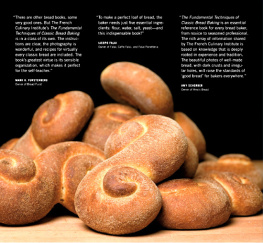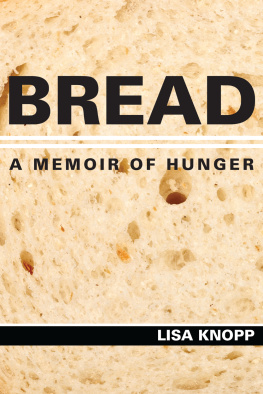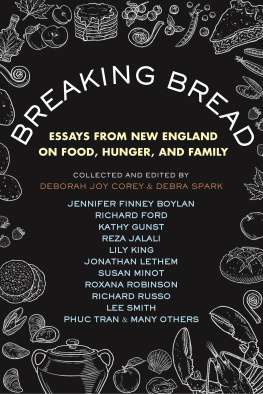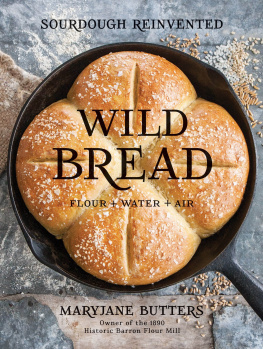advance praise for Bread & Water
dees passions for the visceral stuff of lifefood, cooking, love, running, loving, grievingbeckon us all to the table. Once gathered, her trailblazing life and reflections are set out in this chef-poets characteristic precise and forthright prose. Bread & Water is a perfectly seasoned feast of a life in all its delicious courses. Jennifer Cockrall-King, author of Food and the City and winner of the 2017 Taste Canada Gold Award for Culinary Narratives
The narrative strands in Bread & Water are braided together with a love that comes from a life of paying attention to the way food connects body to earth. Do your heart a favour and let it be charmed by this story of a big city food writer who moves back to the prairie and the leaky-roofed farmhouse of her childhood, reclaiming the family kitchen and the wood stove where she first baked apple turnovers with her grandmother. Hobsbawn-Smith will send you back to your own kitchen and garden, not merely to grow and prepare good food but to do it with care, gratitude, and love. Trevor Herriot, author of Towards a Prairie Atonement
Bread & Water is not only a beautifully written collection of essays, but of a world (dees world) opened up to us one page at a time. Her words are luminescent on the page, weaving together images and stories I wont soon forget. dee will take you down dusty country roads in Saskatchewan, to a cooking school in France, to a cramped Calgary restaurant kitchen, and no matter where you are, her words feel like home. Rene Kohlman, author of All the Sweet Things and Vegetables: A Love Story
I deeply enjoyed this eloquent, lively contemplation of food and its myriad connections to lifeto family and land; to vocation and gender; to abattoirs, farming, and sustainability; and to the way chefs, and all of us, must plan for loss. Throughout these varied essays, dee Hobsbawn-Smith celebrates, in her words, the importance of the meal shared. Alice Major, author of Welcome to the Anthropocene
2021 dee Hobsbawn-Smith
All rights reserved. No part of this work covered by the copyrights hereon may be reproduced or used in any form or by any meansgraphic, electronic, or mechanicalwithout the prior written permission of the publisher. Any request for photocopying, recording, taping or placement in information storage and retrieval systems of any sort shall be directed in writing to Access Copyright.
Printed and bound in Canada at Friesens. The text of this book is printed on 100% post-consumer recycled paper with earth-friendly vegetable-based inks.
Cover art: Bread with water on a dark background by vandame / AdobeStock
Cover and book design: Duncan Campbell, University of Regina Press Copy editor: Kendra Ward Proofreader: Candida Hadley
Library and Archives Canada Cataloguing in Publication
Title : Bread & water : essays / dee Hobsbawn-Smith.
Other titles : Bread and water
Names : Hobsbawn-Smith, Dee, author.
Series : Digestions (Regina, Sask.) ; 4.
Description : Series statement: Digestions ; 4
Identifiers : Canadiana (print) 20210230037 | Canadiana (ebook) 20210230053 | ISBN 9780889778115 (softcover) | ISBN 9780889778221 (hardcover) | ISBN 9780889778238 ( PDF ) | ISBN 9780889778245 ( EPUB )
Subjects: LCGFT: Essays.
Classification: LCC PS8615.O23 B74 2021 | DDC C814/.6 dc23
10 9 8 7 6 5 4 3 2 1
University of Regina Press, University of Regina
Regina, Saskatchewan, Canada, s4s 0a2
tel: (306) 585-4758 fax: (306) 585-4699
web :
We acknowledge the support of the Canada Council for the Arts for our publishing program. We acknowledge the financial support of the Government of Canada. / Nous reconnaissons lappui financier du gouvernement du Canada. This publication was made possible with support from Creative Saskatchewans Book Publishing Production Grant Program.

This book is for my sons,
Darl and Dailyn,
and in memory of my dad,
W. Paul Smith,
and two friends,
Anita Stewart and Madeleine Kamman.
When I write of hunger, I am really writing about love and the hunger for it, and warmth and the love of it and the hunger for it.... There is food in the bowl, and more often than not, because of what honesty I have, there is nourishment in the heart, to feed the wilder, more insistent hungers.
M.F.K. Fisher (19081992), The Art of Eating: The Gastronomical Me (Foreword, 1943)
Contents
Preface
It was 1983, and I was a young cook. My chef at the time was a purist who suffered bureaucrats and fools not at all, but he agreed to write to the provincial apprenticeship board when I asked him for a reference into the program. Id attended a year-long cook-training program at a technical school in Vancouver, and had recently developed fluttering aspirations of cooking my way across Canada to end up in Montreal, the Canadian culinary mecca. The credibility implied by an apprenticeship would help. But I was still green, a beginner in a small but adventurous Calgary restaurant. I knew nothing of nouvelle cuisine, Paul Bocuse, or les frres Troisgros.
One day after my lunch shift ended, Chef put a fantastically small book into my hands. The author was M.F.K. Fisher.
Read this, he said. Then read The Art of Eating. Best food writer ever. Hed already made me read The Auberge of the Flowering Hearth by Roy Andries de Groot and The Making of a Cook by Madeleine Kamman, so I was willing to trust him; learning to cook with Kamman would change my life, as I have chronicled elsewhere.
I had no idea who M.F.K. Fisher wasan aged and revered American food writer and stylist by then only nine years away from her death. Unbeknownst to me at the time, the work of those two iconoclastic womenFisher and Kammanwould plait up my life as securely as the strands in a French braid.
I read the little book, A Cordiall Water , with some amount of disbelief. Incantations and mystery? Ageless faith? The essentials of healing? Chef had called her a food writer, a narrow slot of classification that in my young mind began and ended with restaurant critiques. Then I read Serve It Forth , Consider the Oyster , and How to Cook a Wolf, the first three books contained in Fishers five-book omnibus, The Art of Eating . By the time I finished I thought I knew the authora witty, self-assured, erudite, and beautiful woman who lived, travelled, and ate well, and who had robust opinions on all three. I liked her style, as a woman and as a writer, so I collected her books, filling a shelf with themessays, a novel and short stories, more food, including her Time-Life cookbook on provincial French food, autobiographical works, and two editions of her translation of Brillat-Savarin; then after her death, her collected letters and a few biographies of her. I was a busy young mother, chef, and writer: I promised myself to read them all later.
Four decades later, my restaurant career far behind me, I am close to completing a masters degree in Literature. My thesis focuses on Fishers translation of Brillat-Savarins 1825 classic, The Physiology of Taste . I should be reading D.H. Lawrence and Evelyn Waugh for my class, but today I plan to immerse myself all afternoon and evening in M.F.K. Fisher. It is a deliberate distraction: today we mark the first anniversary of my fathers unexpected and sudden death.
Next page










